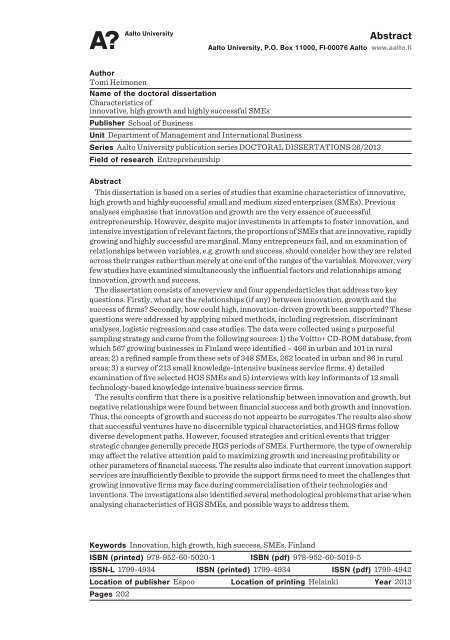dissertation in pdf-format - Aalto-yliopisto
dissertation in pdf-format - Aalto-yliopisto
dissertation in pdf-format - Aalto-yliopisto
Create successful ePaper yourself
Turn your PDF publications into a flip-book with our unique Google optimized e-Paper software.
Author<br />
Tomi Heimonen<br />
Name of the doctoral <strong>dissertation</strong><br />
Characteristics of<br />
<strong>in</strong>novative, high growth and highly successful SMEs<br />
Publisher School of Bus<strong>in</strong>ess<br />
Unit Department of Management and International Bus<strong>in</strong>ess<br />
Abstract<br />
<strong>Aalto</strong> University, P.O. Box 11000, FI-00076 <strong>Aalto</strong> www.aalto.fi<br />
Series <strong>Aalto</strong> University publication series DOCTORAL DISSERTATIONS 26/2013<br />
Field of research Entrepreneurship<br />
Abstract<br />
This <strong>dissertation</strong> is based on a series of studies that exam<strong>in</strong>e characteristics of <strong>in</strong>novative,<br />
high growth and highly successful small and medium sized enterprises (SMEs). Previous<br />
analyses emphasise that <strong>in</strong>novation and growth are the very essence of successful<br />
entrepreneurship. However, despite major <strong>in</strong>vestments <strong>in</strong> attempts to foster <strong>in</strong>novation, and<br />
<strong>in</strong>tensive <strong>in</strong>vestigation of relevant factors, the proportions of SMEs that are <strong>in</strong>novative, rapidly<br />
grow<strong>in</strong>g and highly successful are marg<strong>in</strong>al. Many entrepreneurs fail, and an exam<strong>in</strong>ation of<br />
relationships between variables, e.g. growth and success, should consider how they are related<br />
across their ranges rather than merely at one end of the ranges of the variables. Moreover, very<br />
few studies have exam<strong>in</strong>ed simultaneously the <strong>in</strong>fluential factors and relationships among<br />
<strong>in</strong>novation, growth and success.<br />
The <strong>dissertation</strong> consists of anoverview and four appendedarticles that address two key<br />
questions. Firstly, what are the relationships (if any) between <strong>in</strong>novation, growth and the<br />
success of firms? Secondly, how could high, <strong>in</strong>novation-driven growth been supported? These<br />
questions were addressed by apply<strong>in</strong>g mixed methods, <strong>in</strong>clud<strong>in</strong>g regression, discrim<strong>in</strong>ant<br />
analyses, logistic regression and case studies. The data were collected us<strong>in</strong>g a purposeful<br />
sampl<strong>in</strong>g strategy and came from the follow<strong>in</strong>g sources: 1) the Voitto+ CD-ROM database, from<br />
which 567 grow<strong>in</strong>g bus<strong>in</strong>esses <strong>in</strong> F<strong>in</strong>land were identified – 466 <strong>in</strong> urban and 101 <strong>in</strong> rural<br />
areas; 2) a ref<strong>in</strong>ed sample from these sets of 348 SMEs, 262 located <strong>in</strong> urban and 86 <strong>in</strong> rural<br />
areas; 3) a survey of 213 small knowledge-<strong>in</strong>tensive bus<strong>in</strong>ess service firms, 4) detailed<br />
exam<strong>in</strong>ation of five selected HGS SMEs and 5) <strong>in</strong>terviews with key <strong>in</strong>formants of 12 small<br />
technology-based knowledge <strong>in</strong>tensive bus<strong>in</strong>ess service firms.<br />
The results confirm that there is a positive relationship between <strong>in</strong>novation and growth, but<br />
negative relationships were found between f<strong>in</strong>ancial success and both growth and <strong>in</strong>novation.<br />
Thus, the concepts of growth and success do not appearto be surrogates.The results also show<br />
that successful ventures have no discernible typical characteristics, and HGS firms follow<br />
diverse development paths. However, focused strategies and critical events that trigger<br />
strategic changes generally precede HGS periods of SMEs. Furthermore, the type of ownership<br />
may affect the relative attention paid to maximiz<strong>in</strong>g growth and <strong>in</strong>creas<strong>in</strong>g profitability or<br />
other parameters of f<strong>in</strong>ancial success. The results also <strong>in</strong>dicate that current <strong>in</strong>novation support<br />
services are <strong>in</strong>sufficiently flexible to provide the support firms need to meet the challenges that<br />
grow<strong>in</strong>g <strong>in</strong>novative firms may face dur<strong>in</strong>g commercialisation of their technologies and<br />
<strong>in</strong>ventions. The <strong>in</strong>vestigations also identified several methodological problems that arise when<br />
analys<strong>in</strong>g characteristics of HGS SMEs, and possible ways to address them.<br />
Keywords Innovation, high growth, high success, SMEs, F<strong>in</strong>land<br />
ISBN (pr<strong>in</strong>ted) 978-952-60-5020-1 ISBN (<strong>pdf</strong>) 978-952-60-5019-5<br />
ISSN-L 1799-4934 ISSN (pr<strong>in</strong>ted) 1799-4934 ISSN (<strong>pdf</strong>) 1799-4942<br />
Location of publisher Espoo Location of pr<strong>in</strong>t<strong>in</strong>g Hels<strong>in</strong>ki Year 2013<br />
Pages 202
















